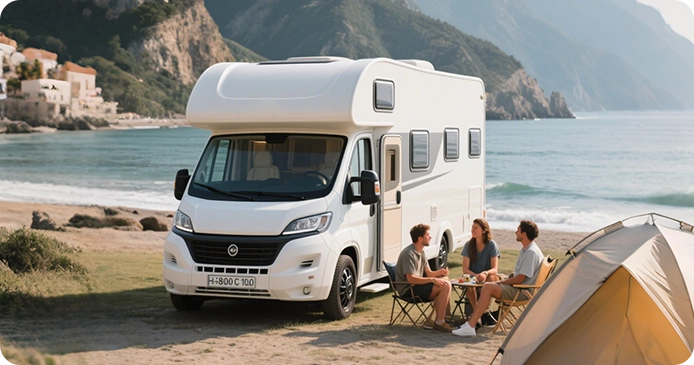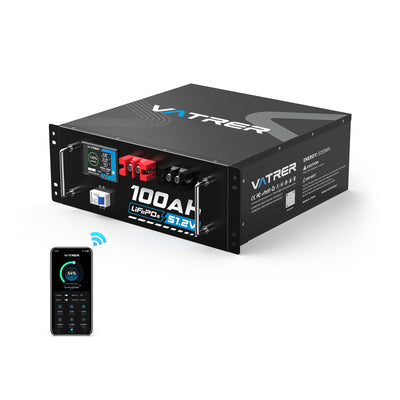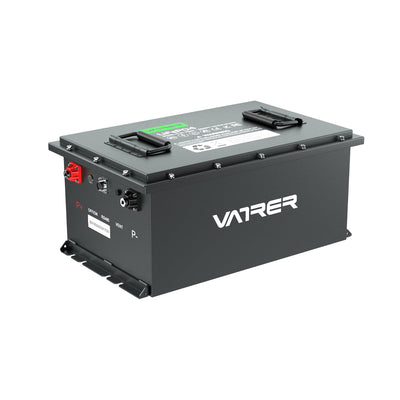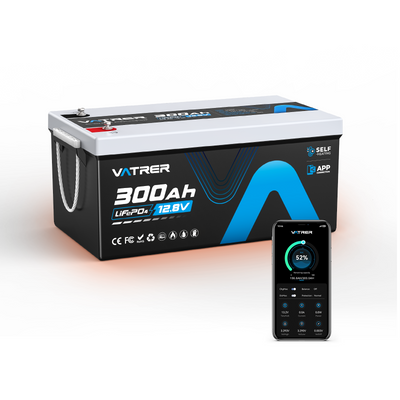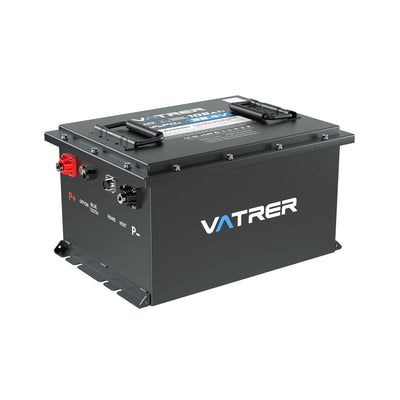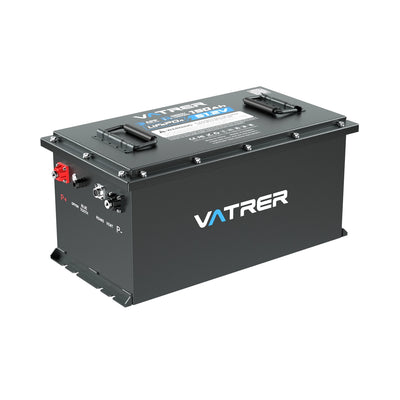
How to Maintain Lithium Batteries for RVs, Marine Vessels, and Golf Carts
Lithium batteries are increasingly popular in recreational vehicles (RVs), marine vessels, and golf carts due to their long life, high energy density, and low maintenance needs compared to traditional lead-acid batteries. However, proper maintenance is essential to maximize their efficiency and lifespan. This blog post will explore the best practices for maintaining lithium batteries in these applications.

Understanding Lithium Batteries for RVs, Marine Vessels, and Golf Carts
Lithium batteries, particularly Lithium Iron Phosphate (LiFePO4), offer distinct advantages over traditional lead-acid batteries.
- They provide an energy density of 150-200 Wh/kg, compared to 30-50 Wh/kg for lead-acid batteries, making them lighter and ideal for RVs and golf carts where weight impacts efficiency.
- Their self-discharge rate of 1-3% per month, versus 5-15% for lead-acid, ensures they retain charge during seasonal storage, such as for boats in winter.
- LiFePO4 batteries also deliver 2,000-5,000 charge cycles, far surpassing the 300-500 cycles of lead-acid batteries, and their stable chemistry enhances safety in marine environments where corrosion is a concern.
For RV users, lithium batteries support extended off-grid camping with consistent power output. In marine vessels, their resistance to vibration and humidity makes them reliable for navigation systems. For golf carts, they handle frequent start-stop cycles efficiently, supporting quick acceleration.
The table below compares key attributes of lithium and lead-acid batteries:
| Battery Type | Weight (per kWh) | Cycle Life | Charge Time | Self-Discharge Rate |
|---|---|---|---|---|
| Lithium (LiFePO4) | 10-15 kg | 2,000-5,000 cycles | 2-4 hours | 1-3% per month |
| Lead-Acid | 30-50 kg | 300-500 cycles | 6-8 hours | 5-15% per month |
These advantages make lithium batteries, especially those in RV lithium battery conversion kits, a practical choice. Understanding their characteristics can help you realize the importance of properly maintaining lithium batteries.
Why Is It So Important To Properly Maintain Lithium Batteries?
Effective lithium-ion battery maintenance maximizes performance, safety, and lifespan.
Neglected maintenance, such as deep discharge or improper storage, can shorten battery life by up to 20%, leading to costly replacements and potential safety risks such as overheating.
- For RV owners, reliable power ensures uninterrupted camping.
- For boat owners, it supports critical navigation.
- For golf cart owners, it maintains consistent performance on the course.
Therefore, by following proper maintenance practices, you can protect your investment and ensure a long-term, reliable power supply.
Maintenance Tips for Optimal Lithium Battery Performance
To help users with lithium-ion battery maintenance tips for various applications, the following provides detailed guidance for specific scenarios, such as RV, boat, and golf cart applications, to help you extend battery life, improve safety, and ensure consistent performance.
Regular Charging to Avoid Deep Discharge
Lithium batteries thrive when maintained between a 20-80% state of charge, unlike lead-acid batteries that tolerate full discharge.
For example, deep discharging a 12V lithium iron phosphate battery below 20%, meaning the voltage drops below 12.4V (the nominal voltage is 12.8V), can damage the battery's chemical structure and shorten its lifespan by up to 20%.
For RV users, it's recommended to charge the battery after each trip using a multimeter to maintain a voltage above 12.8V. Golf cart users should check the charge status weekly to support frequent use. Charging after each use ensures the battery remains fully charged, ready for your next trip, and minimizes wear during discharge cycles.
Using Compatible Chargers for Lithium Batteries
A charger designed for lithium batteries, typically with a Constant Current/Constant Voltage (CC/CV) profile, is essential to prevent overcharging or undercharging, which can damage cells or reduce efficiency. For example, a 14.6V 20A charger is suitable for most 12V LiFePO4 batteries used in RVs or marine vessels. Using a lead-acid charger risks improper voltage regulation, potentially causing safety issues. Check the battery manufacturer's specifications to select a compatible charger, ensuring efficient and safe charging for optimal performance.
Pay Attention to The Temperature Environment to Extend Battery Life
Lithium batteries operate best between 32-113°F (0-45°C). Temperatures below -4°F (-20°C) or above 140°F (60°C) can degrade cells, shortening battery lifespan. For marine vessels, store batteries in a cool, dry compartment away from engine heat. RV owners in cold climates should remove batteries during winter and store them indoors at 59-77°F (15-25°C). Using thermal wraps or insulated battery boxes can further protect against extreme temperatures, ensuring reliable power delivery in challenging conditions.
Keeping Battery Terminals Clean
Regularly cleaning battery terminals ensure efficient power transfer and charging. In marine environments, saltwater exposure can cause corrosion, reducing performance.
Inspect terminals monthly, cleaning with a cloth dampened with isopropyl alcohol or a baking soda-water solution to remove dirt or corrosion. Apply an anti-corrosion spray, such as a silicone-based product, to marine battery terminals to prevent potential issues. For golf carts, check terminals for wear from vibrations, ensuring secure connections to maintain performance.
Proper Storage for Lithium Battery Lifespan
For long-term storage, maintain lithium batteries at a 50% state of charge (around 13.2V for a 12V LiFePO4 battery), as this minimizes chemical stress and capacity loss.
Use a multimeter to confirm the charge level before storage. Store batteries in a cool, dry environment 59-77°F (15-25°C) to avoid extreme temperatures. RV users should disconnect the battery during off-season storage to prevent parasitic drain, while marine users can store batteries in a dry compartment to avoid humidity. Proper storage ensures batteries remain ready for use.
Regular Inspections to Prevent Potential Issues
Checking the battery for any signs of damage regularly, such as every 1-2 months, can help catch problems such as swelling, leakage, or a cracked casing that may indicate a damaged battery.
For marine vessels, check terminals for corrosion due to humidity. Golf cart users should inspect wiring for wear from frequent vibrations. Use a multimeter to ensure battery voltage stays within 12.8-13.6V for a 12V LiFePO4 battery. If signs of damage are detected, replace the battery promptly to avoid safety hazards or performance degradation, ensuring reliable operation.
If you're using it for RV or boat trolling motors, a Vatrer 12V or 24V lithium battery can meet your power supply needs. If you're using it in an electric golf cart, you can upgrade to a Vatrer 36V, 48V, or 72V lithium battery. Our batteries are equipped with a battery management system and Bluetooth protection, allowing you to monitor battery status in real time and provide high-performance, stable power.
Balancing Cells with Battery Management Systems
A battery management system (BMS) helps you monitor battery voltage, temperature, and cell balance in real time, preventing overcharging or deep discharge. For RV lithium batteries, check the BMS functionality quarterly using the manufacturer's diagnostics or an app, such as the Vatrer app, which can alert you to any cell imbalances.
Good BMS maintenance ensures even operation of all battery cells, which is crucial for demanding tasks like boat navigation or golf cart acceleration. If a BMS issue occurs, consult the manufacturer for troubleshooting to maintain battery performance and lifespan.
Updating Firmware for Optimal Battery Performance
Smart lithium batteries often include firmware that optimizes BMS functionality. Check for updates every 3-6 months via the manufacturer's app or website, as updates can improve charge efficiency and safety features.
For instance, Vatrer's LiFePO4 batteries offer firmware updates that enhance performance monitoring. Keeping firmware current ensures batteries deliver consistent power for RV camping, marine adventures, or golf cart use, maximizing reliability.
The following checklist summarizes key maintenance tasks for RV, marine, and golf cart users, ensuring consistent care:
| Application | Task | Frequency | Notes |
|---|---|---|---|
| RV | Verify battery voltage | After each trip | Maintain above 12.8V/25.6V/38.4V/51.2V |
| Marine | Clean and protect terminals | Monthly | Use anti-corrosion spray |
| Golf Cart | Check state of charge | Weekly | Keep at 20-80% |
| All | Inspect for physical damage | Every 1-2 months | Look for swelling or cracks |
| All | Confirm BMS functionality | Quarterly | Check via manufacturer tools |
Conclusion
By following these proper maintenance tips, you can ensure your lithium-ion battery performs well and lasts longer, providing reliable power for RV camping, marine navigation, or golf cart travel. Proper care not only improves performance but also ensures long-term safety and value.




























